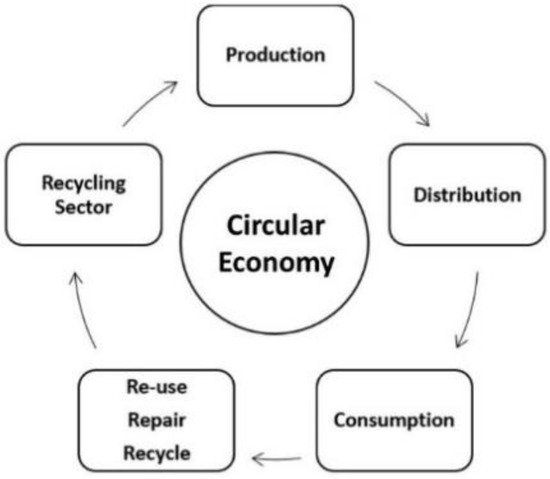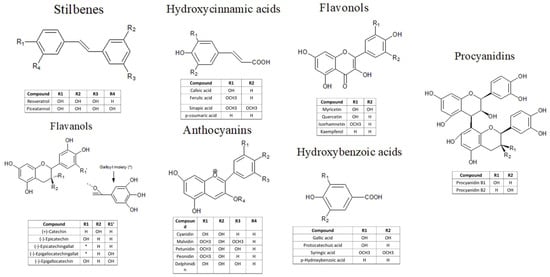Grape pomace (GP) represents a very reliable source of polyphenols because it could be found globally as a remnant of the wine industry. During the winemaking process, two types of GP are generated: red GP and white GP, according to the produced wine, red or white. Grape pomace represents a viable source of polyphenols, mainly flavanols, procyanidins anthocyanins, and resveratrol which possess antioxidant and anti-inflammatory activities. Multiple differences were observed between red and white GP in terms of their antioxidant and anti-inflammatory activity in both in vitro and in vivo studies. Although most studies are focused on the antioxidant and anti-inflammatory effect of red grape pomace, there are still many variables that need to be taken into consideration, as well as extensive study of the white GP. It was observed that in both in vitro and in vivo studies, the GP polyphenols have a direct antioxidant activity by acting as a free radical scavenger or donating a hydrogen atom. It also possesses an indirect antioxidant and anti-inflammatory activity by reducing mitochondrial reactive oxygen species (ROS) generation, malondialdehyde (MDA), tumor necrosis factor-alpha (TNF-α), interleukin-1-beta (IL-1β), interleukin-6 (IL-6), nuclear factor kappa-light-chain-enhancer of activated B cells (NF- κβ), and inhibitor of nuclear factor kappa-B kinase subunit beta (Iκκβ) levels or nitrate oxide-4 (NOX4) expression and by increasing the levels of antioxidants enzymes like superoxide dismutase (SOD), catalase (CAT) glutathione reductase (GRx) and glutathione peroxidase(GPx). Besides these activities, many beneficial effects in ischemic heart diseases were also observed, such as the maintenance of the ventricular function as close as possible to normal, and the prevention of infarcted area extension.
- antioxidant
- anti-inflammatory
- grape pomace
- polyphenols
- ischemic heart diseases
1. Introduction

2. Red and White Grape Pomace—Bioactive Compounds

3. Potentially Toxic Effects of Polyphenols from Red and White Grape Pomace
4. Red and White Grape Pomace—Variability of Total Polyphenols Content and Antioxidant Capacity
|
Grape Pomace (GP) |
TPC (mg GAE */g GP) |
Antioxidant Capacity |
References |
|||
|---|---|---|---|---|---|---|
|
DPPH (μmol TE **/g GP) |
ABTS (μmol TE/g GP) |
FRAP (μmol FeSO4 * 7H2O/g GP) |
||||
|
Vitis vinifera sp. Cultivated in Maipo Valley, Chile |
[15] |
|||||
|
White |
Sauvignon Blanc |
19 |
120 |
- |
- |
|
|
Chardonnay |
17 |
90 |
- |
- |
||
|
Red |
Cabernet Sauvignon |
14 |
60 |
- |
- |
|
|
Carménère |
13 |
70 |
- |
- |
||
|
Vitis vinifera sp. cultivated in Virginia, USA |
[30] |
|||||
|
White |
Vidal Blanc (hybrid variety) |
55.5 |
7.71 |
334 |
- |
|
|
Viognier (Vitis vinifera sp.) |
99.1 |
3.54 |
951 |
- |
||
|
Red |
Cabernet Franc (V. vinifera sp.) |
153.8 |
11.2 |
1013 |
- |
|
|
Chambourcin (hybrid variety) |
92.0 |
28.2 |
378 |
- |
||
|
Vitis vinifera sp. cultivated in Rhineland-Palatinate, Germany |
[32] |
|||||
|
White |
4 varieties of Pinot Blanc and 6 of Riesling |
48 |
- |
- |
- |
|
|
Red |
5 varieties of Dornfelder, 5 of Pinot noir and 2 of Portugais bleu |
58 |
- |
- |
- |
|
|
Vitis vinifera sp. cultivated in Blacksburg, Crozet, Floyd VA, USA |
[33] |
|||||
|
White |
Viognier |
11.8 |
- |
- |
- |
|
|
Vidal Blanc |
12.5 |
- |
- |
- |
||
|
Niagara |
24.8 |
- |
- |
- |
||
|
Petit Manseng |
32.1 |
- |
- |
- |
||
|
Red |
Petit Verdot |
64.8 |
- |
- |
- |
|
|
Merlot |
35.8 |
- |
- |
- |
||
|
Cabernet Franc |
36.1 |
- |
- |
- |
||
|
Chambourcin |
10.4 |
- |
- |
- |
||
|
White |
unknown varieties |
90.51 |
- |
- |
1619 |
[34] |
|
Red |
unknown varieties |
107.40 |
- |
- |
1886 |
|
|
Vitis vinifera sp. cultivated in Cappadocia district of Nevsehir province (Emir), Tokat province (Narince), Sarkoy-Murefte district of Trakya region (Gamay), Ankara province (Kalecik Karasi), Elazig province (Okuzgozu), Turkey |
[35] |
|||||
|
White |
Emir |
75.5 |
- |
- |
- |
|
|
Narince |
138.1 |
- |
- |
- |
||
|
Red |
Gamay |
255.4 |
- |
- |
- |
|
|
Kalecik Karasi |
205.7 |
- |
- |
- |
||
|
Okuzgozu |
281.4 |
- |
- |
- |
||
|
Vitis vinifera sp. cultivated in Blackstone, VA, USA |
[36] |
|||||
|
White |
Chardonnay |
24.5 |
- |
- |
- |
|
|
Red |
Cabernet Franc |
30.4 |
- |
- |
- |
|
|
Vitis vinifera sp. cultivated in Cantine Cantele, Apulia Region, Southern Italy |
[37] |
|||||
|
White |
Fiano |
127.06 |
- |
- |
- |
|
|
Red |
Negramaro |
127.87 |
- |
- |
- |
|
|
Vitis vinifera sp. cultivated in Paros, Greece |
[38] |
|||||
|
White |
Monemvassia |
4.49 |
- |
- |
0.32 |
|
|
Red |
Mandilaria |
5.1 |
- |
- |
0.31 |
|
|
Aidani mavro |
0.25 |
- |
- |
0.21 |
||
* GAE—gallic acid equivalent ** TE—Trolox equivalent.
5. Red and White Grape Pomace—In Vitro Antioxidant and Anti-Inflammatory Activities
|
Materials |
Polyphenols Extracts |
Models |
Antioxidant and Anti-Inflammatory Activity |
References |
|---|---|---|---|---|
|
Grape pomace from different red Vitis vinifera species |
||||
|
GP from Vitis vinifera L. Cagnulari cv. from Santa Maria La Palma, Alghero, Italy |
Water/ethanol (60:40, v/v) extract containing:
|
H2O2-induced oxidative damage in human umbilical vein endothelial cells |
|
[39] |
|
GP from Vitis vinifera L. Batiki Tyrnavou cv. from Greece |
Ethanol extract containing:
|
Tert-butyl hydroperoxide-induced oxidative damage in muscle cells (C2C12) |
|
[40] |
|
Tert-butyl hydroperoxide-induced oxidative damage in endothelial cells (EA.hy926) |
|
|||
|
GP from Vitis vinifera seeds |
- |
UV radiation-induced oxidative stress in human keratinocytes cells (HaCaT cells) |
|
[41] |
|
GP from Vitis vinifera from Valea Calugareasca |
Acetone extract containing:
* higher concentration for procyanidin dimer and epicatechin |
Intestinal inflammation model: LPS-inflammation induced in Caco-2 intestinal cells Symbiotic combination with Lactobacillus sp. as probiotic |
|
[42] |
|
GP from Vitis vinifera variety Montepulciano from Chieti, Italy |
Water extract containing:
|
H2O2-induced oxidative damage in HypoE22 rat hypothalamus cells |
|
[43] |
|
GP from Vitis vinifera L. varieties from Emilia Romagna region, Italy |
Natural deep eutectic solvents (NaDESs) extract containing:
|
Menadione-induced oxidative damage in keratinocyte cells from human skin (HaCaT cells) |
|
[44] |
|
GP from Vitis vinifera L., cv Negramaro from Azienda Agricola Cantele, Guagnano, Lecce, Italy |
Methanol/ethanol (80:20, v/v) extract containing:
|
LPS and TNF-α-induced inflammation in human colorectal adenocarcinoma-derived intestinal epithelial cells (Caco-2 cells) and human microvascular endothelial cells (HMEC-1 cells) |
|
[45] |
|
GP from Vitis vinifera cv Pinot noir from Cautín valley, La Araucanía Region, Chile |
Ethanol extract containing:
|
Polycyclic aromatic hydrocarbons-induced cytotoxicity in endothelial cells |
|
[46] |
|
Grape pomace from different white Vitis vinifera species |
||||
|
GP from Vitis vinifera cv Chardonnay from Lowden, WA, USA |
- |
H2O2-induced oxidative damage in human colonic epithelial cells (Caco-2 cells) |
|
[47] |
|
Red grape pomace versus White grape pomace |
||||
|
GP from Vitis vinifera varieties from Quinta da Cavadinha, Pinhão, Portugal Red: Tinto Cão, Tinta Barroca White: Malvasia Fina, Moscatel Branco |
Methanol/distilled water (70:30, v/v) extract containing:
|
H2O2-induced oxidative damage in human keratinocytes (HaCaT cells) |
|
[48] |
Abbreviations: TIMP1/2—matrix metalloproteinase inhibitors 1/2; MAPK—Mitogen-activated protein kinase; JNK1—c-Jun N-terminal kinase; ERK1/2—Extracellular signal-regulated kinase 1/2; Akt—protein kinase B; P70S6K—ribosomal protein S6 kinase; mTOR—mammalian target of rapamycin; Nrf2—nuclear factor erythroid 2–related factor 2; ROS– Reactive oxygen species; TBARS- Thiobarbituric acid reactive substances; GSH –Glutathione; BDNF—brain-derived neurotrophic factor; PGE2—Prostaglandin E2; LPO—Lipid peroxidation; NF-kB –nuclear factor kappa-light-chain-enhancer of activated B cells; LPS—lipopolysaccharide; TNF-α—tumor necrosis factor; IL-6—Interleukin-6; MCP-1—monocyte chemoattractant protein-1; MMP—matrix metalloproteinases; IL-1β—Interleukin-1-beta; CXCL-10—C-X-C motif chemokine ligand 10; M-CSF—macrophage colony-stimulating factor; COX-2– cyclooxygenase-2; VCAM-1– Vascular Cell Adhesion Molecule 1; ICAM-1– Intercellular Adhesion Molecule 1; H2O2—hydrogen peroxide.
6. Red and White Grape Pomace—In Vivo Antioxidant and Anti-Inflammatory Activities
7. Ischemic Heart Diseases—What We Know So Far and What Can Be Improved
7.1. Risk Factors
7.2. Diagnostics
7.3. Management
7.4. Potential New Therapy
This entry is adapted from the peer-reviewed paper 10.3390/biomedicines10102337
